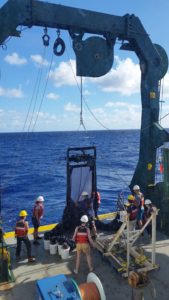
(the MOCNESS lonster!)
The daily commute is a necessary evil many humans participate in. You wake up at an ungodly hour, kiss your happily sleeping partner goodbye for the day, and hop in the car or on to a train to begin the journey to make ends meet. Now imagine that your commute was 130 miles each way and you had to time your commute perfectly to avoid your mortal enemies and certain death. That is the lifestyle of many smaller zooplankton in the ocean that are diel vertical migrators (DVM). Every night copepods, krill and even some small fishes, worms, and sea butterflies swim hundreds of meters from the deep ocean to the surface waters to graze on microscopic plant-like organisms called phytoplankton. Before the sun begins to rise, these diel vertical migrators swim back into the dark reaches of the ocean where their predators, fish with more evolved eyesight, cannot see them. *
Oceanographers can observe this migration using Acoustic Doppler Current Profiler (ADCP), an instrument traditionally used in physical oceanography to track water masses, and echosounders. Much like the fish-finders that recreational anglers use, the zooplankton scatter the acoustic signal and we can see them concentrating below 500 m during the day and swimming up to the surface at night. For the copepod Pleuromama sp., the distance traveled is roughly 120,000 times their body length! During this cruise we will be taking pictures of these DVMs in situ with the Scripps Plankton Camera (SPC), collecting these organisms with MOCNESS and ring net tows, and preserving samples for imaging with ZooScan.
Aside from being a fascinating natural wonder, Diel vertical migration has important implications for oxygen and carbon cycling in the ocean. DVMs are actively transporting carbon from the surface ocean to the deep ocean because they graze phytoplankton in the surface and then poop out this carbon at depth. At St. ALOHA, DVMs are estimated to contribute 10-30% of the carbon exported to depth, a process that allows the ocean to act as a sink for atmospheric CO2. Carbon transport would be less efficient and take 10s of days without the DVM. Diel vertical migration is energetically expensive for zooplankton and can draw down O2 in the deep ocean where they reside during the day. It is hypothesized that this could further deter predators who tend to be more sensitive to O2 depletion than small zooplankton. One of the goals of this cruise is to better understand the impact of DVM on ocean biogeochemistry by measuring how much oxygen they consume, their contribution to carbon export, as well as identifying who makes up this diverse group of organisms.
*Be sure to check out Tom Iwanicki’s forthcoming post detailing how diel vertical migrators use bioluminescence to camouflage themselves during their commute.
